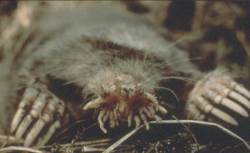|
| 질의: horned owl | 결과: 139번째/141 | |
Star-nosed Mole (Condylura cristata) - Wiki
| 제목: | Star-nosed Mole (Condylura cristata) - Wiki
| |

| 해상도: 250x153
파일크기: 7204 Bytes
등록시간: 2006:12:21 13:32:24
|
Star-nosed mole
From Wikipedia, the free encyclopedia
[Photo] Star-nosed Mole from US NPS. Source: U.S. National Park Service, Acadia National Park
The star-nosed mole, Condylura cristata, is a small North American mole found in eastern Canada and the north-eastern United States. It is the only member of genus Condylura.
It lives in wet lowland areas and eats small invertebrates, aquatic insects, worms and molluscs. It is a good swimmer and can forage along the bottoms of streams and ponds. Like other moles, this animal digs shallow surface tunnels for foraging; often, these tunnels exit underwater. It is active day and night and remains active in winter, when it has been observed tunnelling through the snow and swimming in ice-covered streams. Little is known about the social behavior of the species, but it is suspected that it is colonial.
The Star-nosed mole is covered in thick blackish brown water-repellent fur and has large scaled feet and a long thick tail, which appears to function as a fat storage reserve for the spring breeding season. Adults are 15 to 20 cm in length, weigh about 55 g, and have 44 teeth. The mole's most distinctive feature is a circle of 22 mobile, pink, fleshy tentacles at the end of the snout. These are used to identify food by touch, such as worms, insects and crustaceans.
The incredibly sensitive nasal tentacles are covered with almost one hundred thousand minute touch receptors known as Eimer's organs. These were first described in the European Mole in 1871 by German zoologist Theodor Eimer. Other mole species also possess Eimer's organs, though they are not as specialized or numerous as in the star-nosed mole. Because the star-nose mole is functionally blind, it had long been suspected that the snout was used to detect electrical activity in prey animals, though there is little, if any, empirical support for this contention. It appears the nasal star and dentition of this species are primarily adapted to exploit extremely small prey items. A report in the journal Nature gives this animal the title of fastest-eating mammal, taking only 230 milliseconds to identify and consume individual food items. Its brain decides in the ultra short time of 8 ms if a prey is comestible or not. This speed is at the limit of the speed of neurons.
The star-nosed mole mates in late winter or early spring, and the female has one litter of typically 4 or 5 young in late spring or early summer.
Predators include the Red-tailed Hawk, Great Horned Owl, skunks, various mustelids and even large fish.
http://en.wikipedia.org/wiki/Star-nosed_Mole
| The text in this page is based on the copyrighted Wikipedia article shown in above URL. It is used under the GNU Free Documentation License. You may redistribute it, verbatim or modified, providing that you comply with the terms of the GFDL. |
|
댓글 |
|---|
| | 손님 |
|
Scientific Name: Condylura cristata (Linnaeus, 1758)
Common Names: Star-nosed Mole [English], condylure étoilé [French] |
^o^
동물그림창고 똑똑전화 누리집
^o^
|
|
|